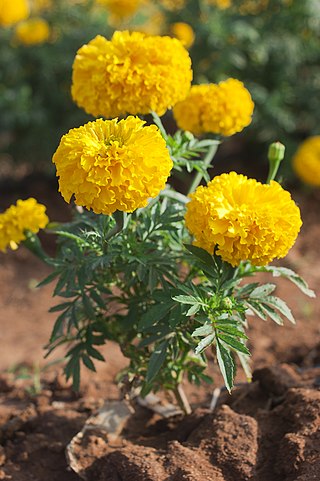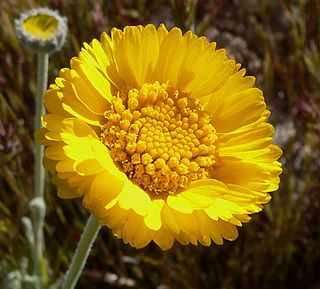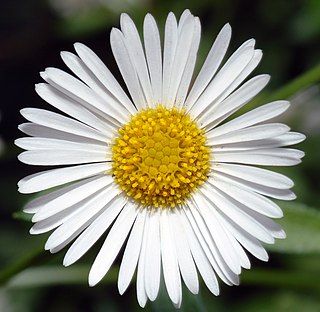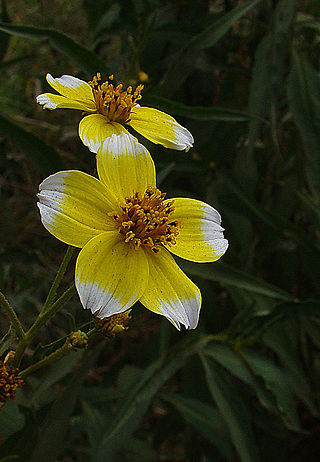
Asteraceae is a large family of flowering plants that consists of over 32,000 known species in over 1,900 genera within the order Asterales. The number of species in Asteraceae is rivaled only by the Orchidaceae, and which is the larger family is unclear as the quantity of extant species in each family is unknown. The Asteraceae were first described in the year 1740 and given the original name Compositae. The family is commonly known as the aster, daisy, composite, or sunflower family.

Dahlia is a genus of bushy, tuberous, herbaceous perennial plants native to Mexico and Central America. Dahlias are members of the Asteraceae family of dicotyledonous plants, its relatives include the sunflower, daisy, chrysanthemum, and zinnia. There are 49 species of dahlia, with flowers in almost every hue, with hybrids commonly grown as garden plants.

Tagetes is a genus of 50 species of annual or perennial, mostly herbaceous plants in the family Asteraceae. They are among several groups of plants known in English as marigolds. The genus Tagetes was described by Carl Linnaeus in 1753.

Pilosella officinarum, known as mouse-ear hawkweed, is a yellow-flowered species of flowering plant in the daisy family Compositae, native to Europe and northern Asia. It produces single, lemon-coloured inflorescences. Like most hawkweed species, it is highly variable and is a member of a species complex of several dozens of subspecies and hundreds of varieties and forms. It is an allelopathic plant.

Grindelia (gumweed) is a genus of plants native to the Americas belonging to the family Asteraceae. The genus was named for Latvian botanist David Hieronymus Grindel, 1776–1836.

Baileya is a genus of plants in the aster family Asteraceae. All are native to the southwestern United States and to Mexico.

Tageteae is a tribe of the plant family Asteraceae. It consists of approximately 260 species divided among 32 genera. All are found in the New World, with a center of diversity in the Mexican highlands. The type genus is Tagetes (marigolds).
Arnicastrum guerrerense, of the family Asteraceae, is a perennial herb with yellow flowers. It is found in Mexico. It was discovered in 1983 in the mountains of Sierra Madre del Sur in the Mexican state of Guerrero and described in the scientific magazine Systematic Botany 3 years later. It was found at 3200m above sea level in a coniferous forest with predominant Pinus hartwegii and Abies. Although it is just known from Mexico, the Mexican red list of endangered plants describes it as non-endemic.

Erigeron karvinskianus, the Mexican fleabane, is a species of daisy-like flowering plant in the family Asteraceae, native to Mexico and parts of Central America.

Thelesperma, commonly known as greenthreads, is a genus of annual or perennial herbs and subshrubs found in the Americas. Members of this genus are closely related to some species of Coreopsis and Bidens. The genus is considered to be within the family Asteraceae.

Barkleyanthus is a monotypic genus of flowering plants in the aster family, Asteraceae, containing the single species Barkleyanthus salicifolius, a plant formerly classified in the genus Senecio. It is native to North and Central America, where its distribution extends from the southwestern United States to El Salvador. Its common names include willow ragwort, willow groundsel, Barkley's-ragwort, and jarilla.

Bidens aurea , the Arizona beggarticks, is a North American species of flowering plant in the family Asteraceae. It is widespread across much of Mexico and found also in Arizona and Guatemala. The species is also naturalized in parts of Europe and South America.

Brickellia coulteri, or Coulter's brickellbush, is a North American species of flowering plants in the family Asteraceae. It is native to Mexico and the southwestern United States.

Chrysactinia mexicana, common name Damianita daisy, is a species of flowering plants in the family Asteraceae, native to Mexico and to the southwestern United States. It has been found in Texas, New Mexico, Aguascalientes, Chihuahua, Coahuila, Durango, Guanajuato, Hidalgo, México State, Nuevo León, Oaxaca, Puebla, Querétaro, San Luis Potosí, Zacatecas, Tamaulipas, and Veracruz.
Chrysactinia acerosa is a Mexican species of flowering plant in the family Asteraceae. It is native to the states of Nuevo León and San Luis Potosí of northeastern Mexico.
Chrysactinia lehtoae is a Mexican species of flowering plants in the family Asteraceae. It is native to northwestern Mexico, found only in pine-oak forests in northern Sinaloa.

Chrysactinia pinnata is a Mexican species of flowering plants in the family Asteraceae. It is native to northeastern Mexico, the states of Coahuila, Nuevo León, Querétaro, San Luis Potosí, and Tamaulipas.

Chrysactinia truncata is a Mexican species of flowering plants in the family Asteraceae. It is native to northeastern Mexico, the states of Coahuila, Nuevo León, Zacatecas, San Luis Potosí, and Tamaulipas.

Cirsium horridulum, called bristly thistle, purple thistle, or yellow thistle is a North American species of plants in the tribe Cardueae within the family Asteraceae. It is an annual or biennial. The species is native to the eastern and southern United States from New England to Florida, Texas, and Oklahoma as well as to Mexico, Belize, Guatemala, Honduras, and the Bahamas.
Tagetes foetidissima is a Mesoamerican species of marigolds in the family Asteraceae. It is widespread across much of Mexico and Central America from Tamaulipas to Costa Rica. Common name is "flor de muerto," Spanish for "death flower."















